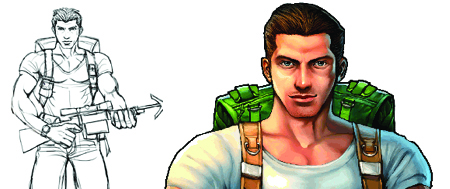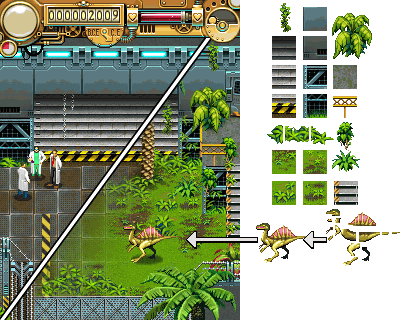Stranded 2 Developer Diary: Part 3
Getting nitty gritty with mobile game artwork

Third in our series of articles following the design of Glu Mobile's second Stranded game by EMEA head of studio Chris White (read part one and part two if you haven't already)
Following the first and second in this series of articles, I’ve hopefully conveyed the design direction in which Stranded: Mysteries Of Time is heading. This month, we will be revealing the techniques and processes involved in producing the game’s artwork.
There are three distinct roles on the Stranded art team: the illustrator, the pixel artist and the 3D artist. The illustrator is responsible for producing high resolution artwork.
This includes the character portraits displayed during dialogue sequences and the full-screen image the player sees when they first launch the game.
Much of this work begins as traditional black and white sketches before being digitally reworked and coloured in Photoshop. As such, the illustrator helps convey the look and feel of certain parts of the game during development.

The time machine was an important visual element to get spot on. We gathered a healthy selection of steam-punk references to create an initial set of sketches.
We drew inspiration from the design of a diving bell, brass organ pipes, and finally decorated the machine with blue neon electricity and mechanical dials and components.
The finished design was referenced by the pixel artist to create a 2D interpretation, and the 3D artist to create a corresponding model.

The pixel artist works in 2D, creating detailed low-resolution graphics, by painstakingly placing individual pixels. Work typically begins in a package called Promotion - essentially a supercharged version of Deluxe Paint on the Amiga.
Following this, effects are added in Photoshop. For Stranded this included subtle details, like dirt on the buildings and additions to the grass textures.
 The large environments in Stranded, including the prehistoric jungle and present day buildings, are pieced together by the pixel artist from smaller graphics, known as tiles. These tiles can be thought of as building blocks, or small squares about the size of an icon on your PC desktop.
The large environments in Stranded, including the prehistoric jungle and present day buildings, are pieced together by the pixel artist from smaller graphics, known as tiles. These tiles can be thought of as building blocks, or small squares about the size of an icon on your PC desktop.
The benefit of using tiles is that we can create massive environments, with a low overhead, in terms of the file size of the game. For this reason, tiles have been successfully used in videogames dating back 30 years to the present day.
The art team worked hard to ensure that the environments do not look like a series of crudely connected blocks, and portray a natural organic world. If you compare Stranded's environments with other tile-based 2D mobile games, you'll hopefully notice the difference!

[This shows how the environments are pieced together. Notice how the environment differs between two time periods]
Tiles aren't suitable for everything. They're restrictive because they must be snapped together in a grid. A lot of the cool visuals in Stranded need to be positioned and moved freely in the environment.
This includes the characters, the dinosaurs, and special features like the time machine.
The artists construct each character animation from a set of smaller components. Therefore, when our protagonist Alex heads dinosaur hunting, we can easily add his tranquiliser gun to his existing set of animations. The animations include walking, shooting, kicking, and chopping down trees.
In total, Alex has 34 unique animations, built from 162 frames. The frames are composites made up from 115 sprite elements. Our latest tools enable us to reuse graphics in many different ways, facilitating a richer diversity of animations than the original game.
We’re pleased with the level of detail in the 2D version, but we’re simultaneously developing a 3D edition for high-end handsets. This involves creating new 3D models and texturing them appropriately.

The more complex models, including palm trees and the time machine, are created within 3DS Max. Corresponding textures are drawn from scratch by the art team.
To save time, some of the simple models, like crates and other square things, are automatically generated by the game engine, and reuse the existing 2D artwork.
.png) Unfortunately, most phones don’t yet possess the graphical acceleration found in consoles. And one of the problems we face is maintaining a smooth frame-rate. This constrains the number of polygons we can squeeze into any one scene. As a result, most models have been optimized to reduce their polygon count and provide the best compromise between quality and frame rate.
Unfortunately, most phones don’t yet possess the graphical acceleration found in consoles. And one of the problems we face is maintaining a smooth frame-rate. This constrains the number of polygons we can squeeze into any one scene. As a result, most models have been optimized to reduce their polygon count and provide the best compromise between quality and frame rate.
One trick is to ensure our textures are as detailed as possible, so that we can remove polygons without sacrificing quality. With hundreds of phones on the market, it’s a challenge to get the trade-off between quality and performance spot-on.
In the next development diary, when we’ll be taking a detailed look at our plans for the high-end version. In the meantime, we’ve produced an exclusive Stranded: Mysteries Of Time trailer for Pocket Gamer which showcases the 2D edition:

We hope you enjoy it! See you next time.
